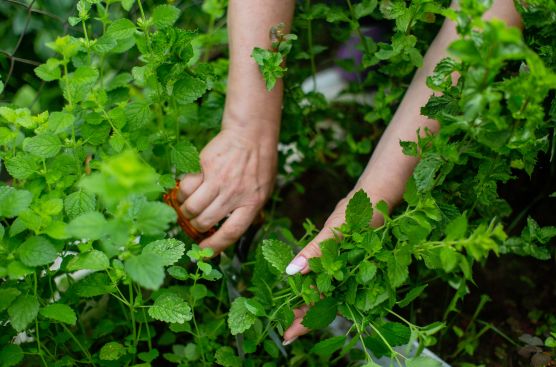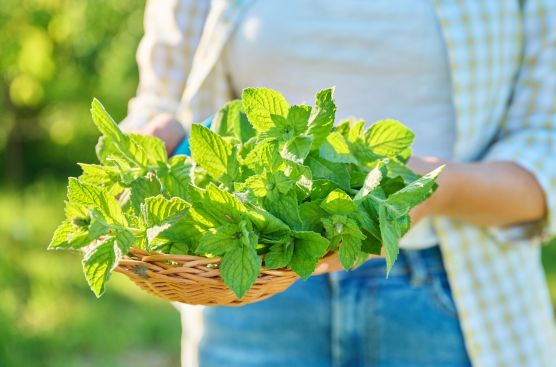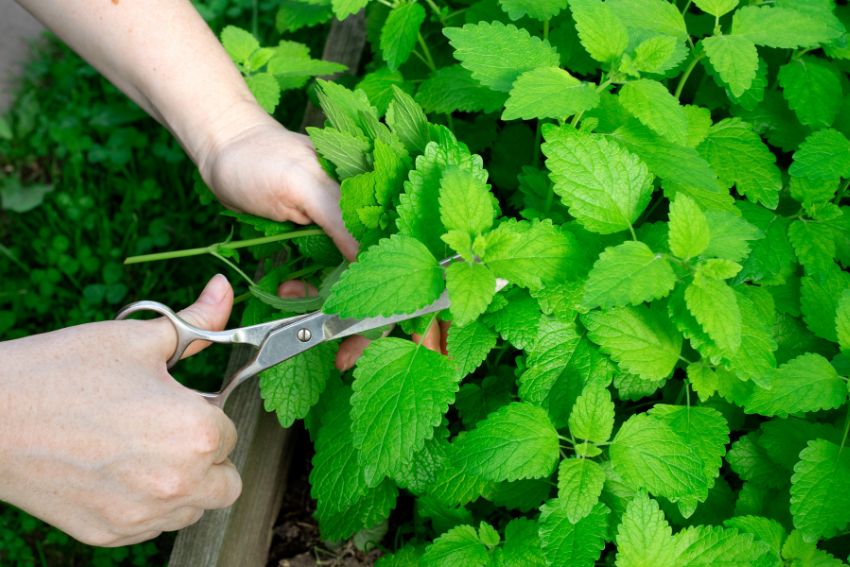Mint is a hardy and fast-growing plant that can spring back from many tough situations. But do not let its strength fool you into thinking it could not die.
More importantly, if you’re growing mint for its leaves, your goal should be to have a healthy plant with aromatic shoots rather than a plant that is simply “surviving.”
Learning how to harvest mint without killing the plant becomes important in such cases. There’s a short answer and a detailed answer.
Here’s the short version first:
- Before harvesting, ensure the plant is at least 4-6 inches tall.
- Cut the leaves using sharp scissors or shears, and avoid pinching or pulling the leaves/stems.
- Avoid harvesting more than 1/3rd of the plant at a time, and let the plant reach the same height before the next harvest.
Even though these tips will get you started, there’s more to learn if you want a bountiful and flavorful harvest without killing your mint plant.
That is what this article is all about, as it covers detailed expert tips, best practices, and personal advice when it comes to harvesting a mint plant.
Best Practices to Harvest Mint Without Killing the Plant
Considering Plant’s Growth Before Harvesting

The first step to safely harvesting your mint plant is determining its growth.
If you have planted a transplant, it’d roughly take 30 days for the plant to grow mature leaves. On the other hand, if you are growing from a seed, it’d take around 70-90 days.
After this period, your plant should ideally have enough leaves to be harvested. If you can’t keep track of time, there’s a simpler way, and one that I prefer.
If your mint plant has reached a height of about 4-6 inches, you can harvest it. Ensure the plant has enough leaves that you can leave at least two sections after harvesting.
Harvesting the Right Quantity
You might have heard that mint is a fast-growing plant that can often become invasive. That is true, but new gardeners may also endanger them by cutting too much at a time.
When a mint plant loses many leaves in one go, it can become stressed and eventually die. Therefore, it is best to never cut more than 1/3rd of the plant’s leaves at a time.
It is just enough for the plant to channel nutrition to produce new leaves without unbearable stress.
Using Sharp Tools and Appropriate Technique

You might be tempted to simply grab a few leaves and pinch them off the stems, but you should know that this can damage the stems of the plant and make them susceptible to diseases.
Similarly, pulling the leaves can dislodge and damage the roots, making them more vulnerable to diseases and pests.
The best way to collect mint plant leaves is to use sharp garden scissors or shears when cutting the leaves. Using a knife is also discouraged as its sawing motion can bruise the stems.
You should also be careful about where and which leaves you cut.
Cutting the leaves just above the nodes (where the stem branches off into a pair of leaves) instead of internodes (the part between two nodes) will ensure that the stems are not needlessly exposed to diseases. Cut younger leaves at the bottom instead of older ones for the best flavor.
Harvesting as Frequently as the Plant Allows
The best thing about mint is that it can last up to a decade if you harvest it regularly. A mint plant puts out new leaves during spring (growing season). If you start harvesting during this time, the plant will develop new foliage each season.
After each harvest, a mint plant takes 30-45 days to regrow to the same height. If you harvest your mint plant every time it grows to a height of 4-6 inches, you will encourage fresh growth, and your plant can last 5-10 years.
Not Letting the Plant Flower
Mint is a perennial, which means that, unlike annual plants, it doesn’t die off once it flowers. However, you should still not let your mint plant flower if you wish to harvest it for a long time.
When a mint plant flowers, it focuses its energies and nutrients on reproduction, also known as “bolting.” It is a natural part of its growth cycle. But this can be bad for those interested in harvesting mint leaves.
As nutrients are directed toward flowers, the plant becomes less focused on leaves. This results in the leaves losing their best flavor for the sake of reproduction.
But there’s more.
A flowering mint plant becomes less interested in growing more foliage. If you notice flowers blooming, you’ll also notice the leaves grow with less zeal than before.
Regularly cutting off buds as soon as you spot them will lead the plant to grow the leaves much faster, giving you a bountiful harvest every time.

Harvesting at the Right Time
Here’s a little bonus tip if you want your mint harvests to have the best flavor.
Set the alarm for early morning, just when the dew has dried, but the sunlight is still cool and mild. Ideally, this is when you should harvest your mint. The concentration of flavor-rich essential oils is highest in the mint leaves at this time. As the sun gets more intense, the concentration of these oils is reduced in the leaves.
You should also focus on when your plant starts forming buds. The leaves are at their peak flavor when the buds form. Simply cut off the buds and harvest the leaves.
Final Words
Harvesting a mint plant so it doesn’t die is easy. Just taking care of a few basic things like the growth of the plant (4-6 inches), sharp scissors, and harvesting the right amount (1/3rd at a time) will be enough. But you might be unaware of these seemingly basic things if you’re a new gardener.
Therefore, brushing up on best harvesting practices is always a good idea, regardless of the plant you’re growing. Lastly, speaking from personal experience, you will also make mistakes and lose some plants. But that is a part of the learning process, and you shouldn’t beat yourself up too much about it.
FAQs
- How do you pick mint to keep it growing?
The best way to pick mint that promotes growth is to cut only 1/3rd of the plant at a time and snip off buds as soon as you see them. When the leaves are regularly picked, and the plant doesn’t flower, all the energy will be directed toward producing lush foliage.
- Does mint regrow after cutting?
Mint can easily regrow after cutting if you know how to do it correctly. Cutting the 1/3rd of the plant will prevent you from putting any stress on it and encourage the growth of new leaves. Cutting buds and not letting the plant flower will also direct resources toward the growth of new leaves.
It takes a mint plant about 30-45 days to regrow to the same height after a cutting.
- What makes mint grow faster?
To help your mint plant grow faster:
- Harvest it during the spring when it starts putting out new leaves.
- Harvest the plant whenever it reaches a height of about 4-6 inches, ensuring not to cut more than 1/3rd of the plant.
- Cut off buds as soon as you spot them, and do not let your plant flower.
All these things will help your mint plant grow faster.
- Where do you cut mint?
The right way to cut mint is above the node where the stem branches into leaves. Cutting at the internode (stem between two nodes) makes your mint plant vulnerable to diseases.
- When should you harvest mint?
Mint plants put out new leaves during spring. You should harvest them during this time, first ensuring the plant is at least 4-6 inches tall. For the best flavor, harvest the leaves early in the morning when the buds have formed. Cut off the buds to prevent flowering.
